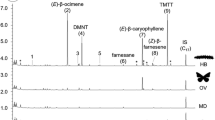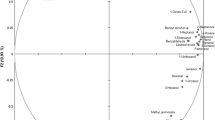Abstract
Analyses of volatiles emitted from artificially damaged leaves attached to branches of seven Magnolia taxa revealed the presence of (Z)-3-hexenyl acetate, (Z)-3-hexenol (the green odor compounds), and several mono- and sesquiterpenes, e.g., (Z)- and (E)-β-ocimene and caryophyllene. An herbivore-induced leaf volatile, (E)-4,8-dimethyl-1,3,7-nonatriene, known as a predator attractant in agricultural plants, was emitted 4–6 hr after leaves were damaged in M. hypoleuca. The damaged leaves of M. grandiflora, however, immediately released (E)-4,8-dimethyl-1,3,7-nonatriene. Undamaged leaves of Magnolia species examined did not emit volatile compounds. In addition, detached flowers of six Magnolia taxa and Liriodendron tulipifera also emit (E)-4,8-dimemyl-1,3,7-nonatriene as a floral volatile (up to 30% in some species); the chemical was also emitted from the intact flowers of M. heptapeta and M. salicifolia.
Similar content being viewed by others
REFERENCES
ANDERSEN, R. A., HAMILTON-KEMP, T. R., LOUGHRIN, J. H., HUGHES, C. G., HILDEBRAND, D. F., and SUTTON, T. G. 1988. Green leaf headspace volatiles from Nicotiana tabacum lines of different trichome morphology. J. Agric. Food Chem. 36:295–299.
BOLAND, W., FENG, Z., DONATH, J., and GÄBLER, A. 1992. Are acyclic C11 and Cl6 homoterpenes plant volatiles indicating herbivory? Naturwissenschaften 79:368–371.
BOLAND, W., HOPKE, J., DONATH, J., NÜSKE, J., and BUBLITZ, F. 1995. Jasmonic acid and coronatin induce odor production in plants. Angew. Chem. Int. Ed. Engl. 34:1600–1602.
CHEW, F. S. 1988. Searching for defensive chemistry in the Cruciferae, or, do glucosinolates always control interactions of Cruciferae with their potential herbivores and symbionts? No!, pp. 81–112, in K. C. Spencer (ed.). Chemical Mediation of Coevolution. Academic Press, San Diego.
DICKR, M., and SABELIS, M. W. 1992. Costs and benefits of chemical information conveyance: Proximate and ultimate factors, pp. 122–155, in B. D. Roitberg and M. B. Isman (eds.). Insect Chemical Ecology; An Evolutionary Approach. Chapman and Hall, New York.
EHRLICH, P. R., and RAVEN, P.H. 1964. Butterflies and plants: A study in coevolution. Evolution 18:586–608.
FARMER, E. E., and RYAN, C. A. 1990. Interplant communication: Airborne methyl jasmonate induces synthesis of proteinase inhibitors in plant leaves. Proc. Natl. Acad. Sci. U.S.A. 87:7713–7716.
GREENWALD, R., CHAYKOVSKY, M., and COREY, E. J. 1963. The Wittig reaction using methylsulfinyl carbanion-dimethyl sulfoxide. J. Org. Chem. 28:1128–1129.
HARBORNE, J. B. 1993. Introduction to Ecological Biochemistry, 4th ed. Academic Press, London.
HATANAKA, A. 1993. The biogeneration of green odour by green leaves. Phytochemistry 34:1201–1218.
JAKOBSEN, H. B., FRIJS, P., NIELSEN, J. K., and OLSEN, C. E. 1994. Emission of volatiles from flowers and leaves of Brassica napus in situ. Phytochemistry 37:695–699.
KAISER, R. 1991. Trapping, investigation, and reconstitution of flower scents, pp. 213–253, in P. M. Muller and D. Lamparsky (eds.). Perfumes: Art, Science, and Technology. Elsevier Applied Science, New York.
KNUDSEN, J. T., and MORI, S. A. 1996. Floral scents and pollination in neotropical Lecythidaceae. Biotropica 28:42–60.
KNUDSEN, J. T., TOLLSTEN, L., and BERGSTRÖM, L. G. 1993. Floral scents—a checklist of volatile compounds isolated by head-space techniques. Phytochemistry 33:253–280.
LI, Y., DICKENS, J. C., and STEINER, W. W. M. 1992. Antennal olfactory responsiveness of Microplitis croceipes (Hymenoptera: Braconidae) to cotton plant volatiles. J. Chem. Ecol. 18:1761–1773.
LOUGHRIN, J. H., MANUKIAN, A., HEATH, R. R., TURLINGS, T. C. J., and TUMLINSON, J. H. 1994. Diurnal cycle of emission of induced volatile terpenoids by herbivore-injured cotton plants. Proc. Natl. Acad. Sci. U.S.A. 91:11836–11840.
LOUGHRIN, J. H., MANUKIAN, A., HEATH, R. R., and TUMLINSON, J. H. 1995. Volatiles emitted by different cotton varieties damaged by feeding beet armyworm larvae. J. Chem. Ecol. 21:1217–1227.
MATTIACCI, L., DICKE, M., and POSTHUMUS, M. A. 1994. Induction of parasitoid attracting synomone in Brussels sprouts plants by feeding of Pieris brassicae larvae: Role of mechanical damage and herbivore elicitor. J. Chem. Ecol. 20:2229–2247.
MATTIACCI, L., DICKE, M., and POSTHUMUS, M. A. 1995. β-Glucosidase: An elicitor of herbivore-induced plant odor that attracts host-searching parasitic wasps. Proc. Natl. Acad. Sci. U.S.A. 92:2036–2040.
PELLMYR, O., and THIEN, L. B. 1986. Insect reproduction and floral fragrances: Keys to the evolution of the angiosperms? Taxon 35:76–85.
PELLMYR, O., TANG, W., GROTH, I., BERGSTROM, G., and THIEN, L. B. 1991. Cycad cone and angiosperm floral volatiles: Inferences for the evolution of insect pollination. Biochem. Syst. Ecol. 19:623–627.
PRICE, P. W., BOUTON, C. E., GROSS, P., MC PHERON, B. A., THOMPSON, J. N., and WEIS, A. E. 1980. Interactions among three trophic levels: Influence of plants on interactions between insect herbivores and natural enemies. Annu. Rev. Ecol. Syst. 11:41–65.
RHOADES, D. F. 1979. Evolution of plant chemical defenses against herbivores, pp. 3–48, in G. A. Rosenthal and D. H. Janzen (eds.). Herbivores—Their Interaction with Secondary Plant Metabolites. Academic Press, New York.
ROSE, U. S. R., MANUKIAN, A., HEATH, R. R., and TUMLINSON, J. H. 1996. Volatile semiochemicals released from undamaged cotton leaves: A systemic response of living plants to caterpillar damage. Plant Physiol. 111:487–495.
SCRIBER, J. M. 1988. Tale of the tiger: Beringial biogeography, binomial classification, and breakfast choices in the Papilio glaucus complex of butterflies, pp. 241–301, in K. C. Spencer (ed.). Chemical Mediation of Coevolution. Academic Press, San Diego.
SHULAEV, V., SILVERMAN, P., and RASKIN, I. 1997. Airborne signalling by methyl salicylate in plant pathogen resistance. Nature 385:718–721.
SPENCER, K. C. 1988. Chemical mediation of coevolution in the Passiflora-Heliconius interaction, pp. 167–240, in K. C. Spencer (ed.). Chemical Mediation of Coevolution. Academic Press, San Diego.
TAKABAYASHI, J., DICKE, M., and POSTHUMUS, M. A. 1994a. Volatile herbivore-induced terpenoids in plant-mite interactions: Variation caused by biotic and abiotic factors. J. Chem. Ecol. 20:1329–1354.
TAKABAYASHI, J., DICKE, M., TAKAHASHI, S., POSTHUMUS, M. A., and VAN BEEK, T. A. 1994b. Leaf age affects composition of herbivore-induced synomones and attraction of predatory mites. J. Chem. Ecol. 20:373–386.
THIEN, L. B. 1974. Floral biology of Magnolia. Am. J. Bot. 61:1037–1045.
THIEN, L. B., HEIMERMANN, W. H., and HOLMAN, R. T. 1975. Floral odors and quantitative taxonomy of Magnolia and Liriodendron. Taxon 24:557–568.
THORNE, R. F. 1996. The least specialized angiosperms, pp. 286–313, in D. W. Taylor and L. J. Hickey (eds.). Flowering Plant Origin, Evolution and Phytogeny. Chapman and Hall, New York.
TRESEDER, N. G. 1978. Magnolias. Faber and Faber, London.
TURLINGS, T. C. J., and TUMLINSON, J. H. 1992. Systemic release of chemical signals by herbivore-injured corn. Proc. Natl. Acad. Sci. U.S.A. 89:8399–8402.
TURLINGS, T. C. J., TUMLINSON, J. H., and LEWIS, W. J. 1990. Exploitation of herbivore-induced plant odors by host-seeking parasitic wasps. Science 250:1251–1253.
TURLINGS, T. C. J., LOUGHRIN, J. H., MC CALL, P. J., ROSE, U. S. R., LEWIS, W. J. and TUMLINSON, J. H. 1995. How caterpillar-damaged plants protect themselves by attracting parasitic wasps. Proc. Natl. Acad. Sci. U.S.A. 92:4169–4174.
UEDA, K. 1980. Taxonomic study of Magnolia sieboldii C. Koch. Acta Phylotax. Geobot. 31:117–125.
UEDA, K. 1985. A nomenclaturel revision of the Japanese Magnolia species (Magnoliac.), together with two long-cultivated Chinese species. III. M. heptapeta and M. quinquepeta. Acta Phytotax. Geobot. 36:149–161.
UEDA, K. 1986a. A nomenclatural revision of the Japanese Magnolia species (Magnoliaceae) together with two long-cultivated Chinese species. I. M. hypoleuca. Taxon 35:340–344.
UEDA, K. 1986b. A nomenclatural revision of the Japanese Magnolia species (Magnoliaceae) together with two long-cultivated Chinese species. II. M. tomentosa and M. praecocissima. Taxon 35:344–347.
WILLIAMS, N. H., and WHITTEN, W. M. 1983. Orchid floral fragrances and male euglossine bees: Methods and advances in the last sesquidecade. Biol. Bull. 164:355–395.
WOOD, D. L. 1982. The role of pheromones, kairomones, and allomones in the host selection and colonization behavior of bark bettles. Annu. Rev. Entomal. 27:411–446.
YASUKAWA, S., KATO, H., YAMAOKA, R., TANAKA, H., ARAI, H., and KAWANO, S. 1992. Reproductive and pollination biology of Magnolia and its allied genera (Magnoliaceae) I. Floral volatiles of several Magnolia and Michelia species and their roles in attracting insects. Plant Species Biol. 7:121–140.
Author information
Authors and Affiliations
Rights and permissions
About this article
Cite this article
Azuma, H., Thien, L.B., Toyota, M. et al. Distribution and Differential Expression of (E)-4,8-Dimethyl-1,3,7-Nonatriene in Leaf and Floral Volatiles of Magnolia and Liriodendron Taxa. J Chem Ecol 23, 2467–2478 (1997). https://doi.org/10.1023/B:JOEC.0000006660.84363.1b
Issue Date:
DOI: https://doi.org/10.1023/B:JOEC.0000006660.84363.1b




